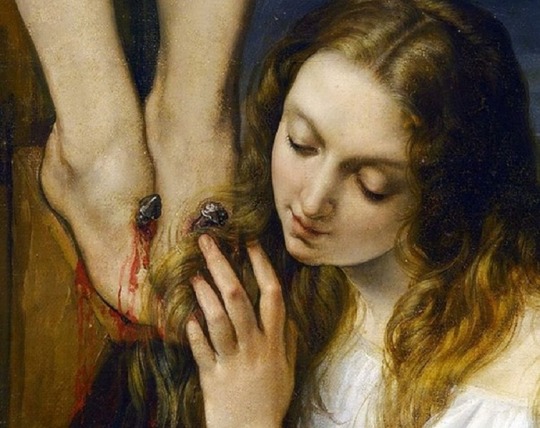Text
Magic circle from MS.3203, 1843-1869, Wellcome Collection, London.

31 notes
·
View notes
Photo

Francesco Hayez - Crucifixion with Mary Magdalene Kneeling and Weeping, 1827, detail
9K notes
·
View notes
Text

Body, Mind, Soul.
Differently from the common knowledge, the holy Trinity is not a concept related only to Christianity. Throughout history, many cultures have embraced the concept of divine trinities, seeing the sacred in groups of three.
In ancient Egypt, the gods Amun, Re, and Ptah formed a powerful triad. A hymn from the Leiden Hymns declares: “All gods are three: Amun, Re, and Ptah.” Similarly, the Babylonians revered the trio of Nanna, Shamash, and Ishtar, each representing different celestial and life forces.
Hinduism presents the Trimurti, where the supreme god, Brahman, manifests in three forms: Brahma the creator, Vishnu the preserver, and Shiva the destroyer. The Padma Purana affirms this, stating: “He who is that eternal God became the three gods—Brahma, Vishnu, and Shiva.”
The Greeks honored Hekate, a deity often depicted as triple-headed and associated with crossroads and magic. The Romans similarly venerated Diana as “Diva Triformis”, the three-formed goddess, as reflected in Horace’s Odes: “O three-formed goddess, to thee I dedicate the pine-tree.”
In Northwestern Europe, tribes worshipped the Matronae, a group of three mother goddesses symbolizing fertility, protection, and fate. Meanwhile, in Persia, a divine triad of Ahura Mazda, Mithra, and Anahita was central to spiritual life. A royal Achaemenid inscription invokes their protection: “May Ahura Mazda, Anahita, and Mithra protect me and my building against evil.”
These trinities reflect a widespread belief in the power of three—a sacred number embodying balance, completeness, and divine harmony across civilizations.
#demiurge#gnosis#gnostic christianity#gnostic gospels#gnostic teachings#gnosticism#pistis sophia#pleroma#occult#esoteric#occultism#trinity#omnism#omnist
6 notes
·
View notes
Text

Sascha Schneider (1870–1927) - The Embers, 1904
650 notes
·
View notes
Text

Georges Coutan (1853–1890) - “Metamorphosis of the Magician”
illustration from the book ‘Les Mystères du Peuple’, 1880
584 notes
·
View notes
Text

William Blake, The Ancient of Days (1794), depicting the act of creation by means of a compass
#gnosis#gnostic gospels#gnostic teachings#gnostic christianity#gnosticism#pleroma#pistis sophia#demiurge#philosophy
3 notes
·
View notes
Text

Eve and the Serpent, in a painting by William Blake (1799): in Gnostic cosmology, Eve is a personification of Sophia or Gnosis, the divine mother who represents wisdom as the (feminine) aspect of God
#gnosticism#gnostic christianity#gnostic teachings#gnostic gospels#gnosis#pistis sophia#demiurge#pleroma#philosophy
93 notes
·
View notes




